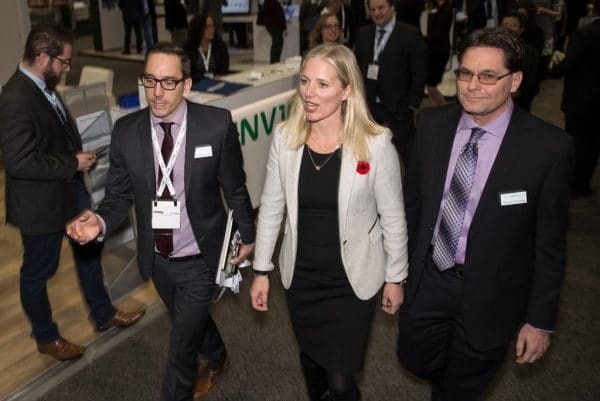Wind energy is already central to many greenhouse gas emission-reduction strategies across Canada. And it is poised to play an even bigger role as provinces seek cost-effective strategies to meet long-term climate change goals and the federal government prioritizes the building of a clean growth economy.

CanWEA 2016’s keynote speaker, Honorable Catherine McKenna (Canada’s Federal Minister of the Environment and Climate Change), spoke of the important role that wind energy plays in her government’s efforts to address the challenge of climate change.
This was part of the keynote Honorable Catherine McKenna, Canada’s Federal Minister of Environment and Climate Change, delivered during the second day of the Canadian Wind Energy Association’s (CanWEA) 32nd Annual Conference and Exhibition in Calgary this week.
Minister McKenna said that the federal government aims to source 100% of the electricity for its operations from renewable energy by 2025.
“As the world meets next week for the COP22 climate talks, Canada will have a chance to demonstrate the concrete steps we are taking to reduce greenhouse gases and lead the transition to a clean growth economy,” said Minister McKenna. “We know that Canada’s tremendous renewable energy resources, like wind, must be a part of the plan.”
“The federal government’s announcement that it will source 100% of the electricity for its operations from renewable energy provides more evidence that federal and provincial governments are accelerating their efforts to address the risks of climate change,” said CanWEA President, Robert Hornung.
He added: “We remain confident that wind energy will continue to be a key component of Canada’s efforts to reduce greenhouse gas emissions.”
Complementing the Minister’s address, the conference delved into the technical, policy, and market drivers that are shaping Canada’s evolving energy industry. The combination of low wind prices and zero emissions makes wind energy a leading source of permanent, large-scale and affordable greenhouse gas reductions.

A visual showcase of submissions from CanWEA’s annual Power of Wind bursary contest are also display at this week’s annual conference and exhibition in Calgary. (Credit: Bryan Passifiume | CanWEA)
It is clear that wind energy will play an important role in cleaning electricity grids in Alberta and Saskatchewan, and across Canada clean electricity grids will be needed for reducing fossil fuel use in other sectors through electrification and in the U.S. through clean energy exports.
In addition to high-level policy discussions and market analysis, the CanWEA conference sessions also gave delegates a chance to gain insight into the science of assessing wind as a resource, data-driven strategies to improve project performance, models of community engagement, and the evolution of storage technologies.
Many of the event’s 1,600 participants also took to the tradeshow floor to learn more about the technological advancements and operational innovations that continue to reduce the cost of wind energy, after already driving it down more than 60% in the past six years alone, according to data from the Unites States (Lazard 2015.)
“CanWEA 2016 has seen a lot of interest from investors, project developers, equipment suppliers, and service providers who see real opportunity in Canadian wind energy, especially as Alberta and Saskatchewan move to grow wind energy production in a big way,” said Larry Turner, President and CEO of Hannover Fairs.
Filed Under: News, Policy, Projects




